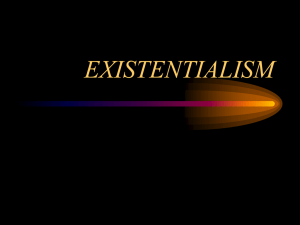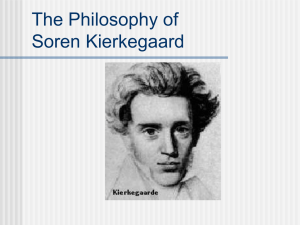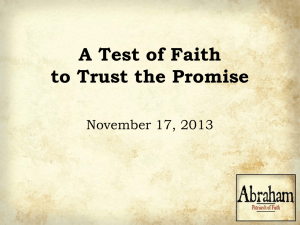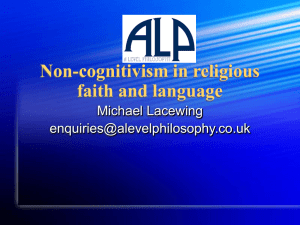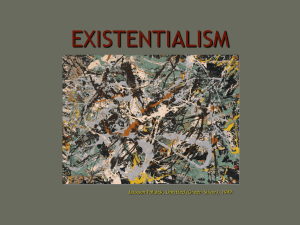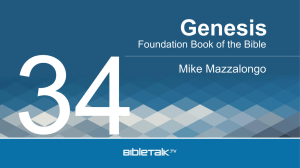Kierkegaard`s Fear and Trembling
advertisement
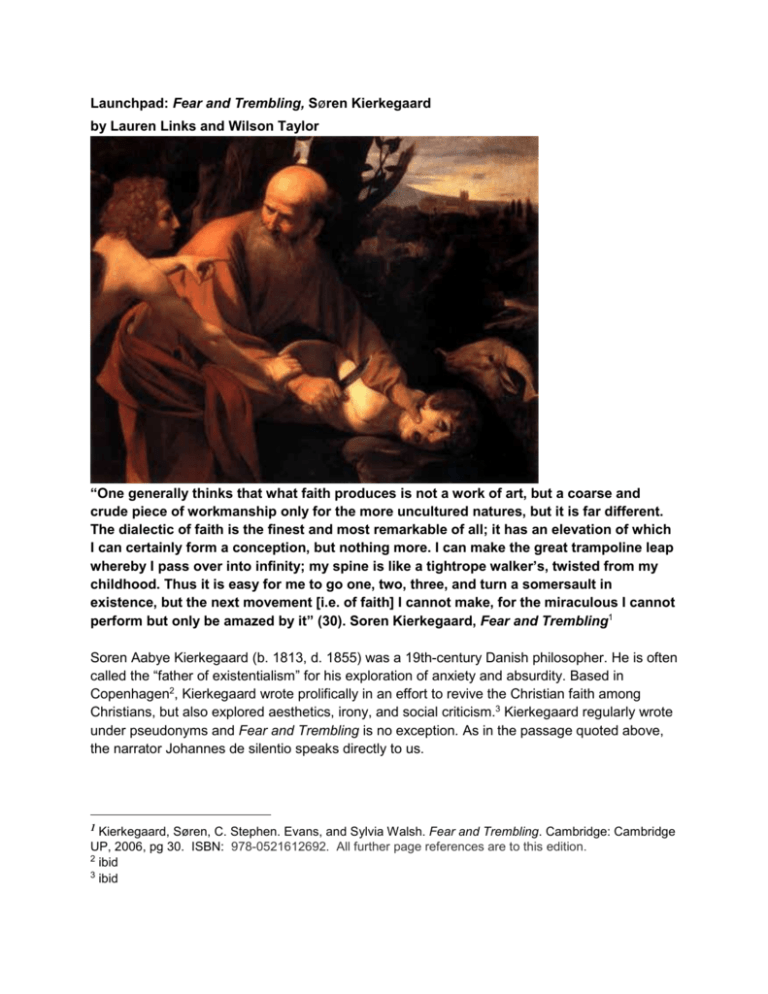
Launchpad: Fear and Trembling, Søren Kierkegaard by Lauren Links and Wilson Taylor “One generally thinks that what faith produces is not a work of art, but a coarse and crude piece of workmanship only for the more uncultured natures, but it is far different. The dialectic of faith is the finest and most remarkable of all; it has an elevation of which I can certainly form a conception, but nothing more. I can make the great trampoline leap whereby I pass over into infinity; my spine is like a tightrope walker’s, twisted from my childhood. Thus it is easy for me to go one, two, three, and turn a somersault in existence, but the next movement [i.e. of faith] I cannot make, for the miraculous I cannot perform but only be amazed by it” (30). Soren Kierkegaard, Fear and Trembling1 Soren Aabye Kierkegaard (b. 1813, d. 1855) was a 19th-century Danish philosopher. He is often called the “father of existentialism” for his exploration of anxiety and absurdity. Based in Copenhagen2, Kierkegaard wrote prolifically in an effort to revive the Christian faith among Christians, but also explored aesthetics, irony, and social criticism.3 Kierkegaard regularly wrote under pseudonyms and Fear and Trembling is no exception. As in the passage quoted above, the narrator Johannes de silentio speaks directly to us. 1 Kierkegaard, Søren, C. Stephen. Evans, and Sylvia Walsh. Fear and Trembling. Cambridge: Cambridge UP, 2006, pg 30. ISBN: 978-0521612692. All further page references are to this edition. 2 ibid 3 ibid Kierkegaard published Fear and Trembling in 1843. Kierkegaard hoped to problematize what he felt were overly simplistic and uncritical interpretations of Christianity. In order to do so, Kierkegaard centers his existential exploration of Christianity on the figure of Abraham, who is called by God in Genesis 22 to sacrifice his son, Isaac. Kierkegaard rejects abstracted narratives of Abraham’s sacrifice (such as interpreting the ordeal as a parable of faith) and guides the reader to reckon with Abraham’s anxiety. While Kierkegaard does highlight Abraham’s faith, this faith is quite unlike more popularly accepted understandings of the term. Rather than a genteel piety within a culture of Christendom, Kierkegaard understands Abraham’s faith as highly isolating, anxiety-ridden, and absurd. Ultimately, Kierkegaard articulates a highly existential understanding of the self and of Christianity, presenting a vision where the individual may transcend society and universal mores. More information on Kierkegaard can be found here: http://plato.stanford.edu/entries/kierkegaard/ http://www.iep.utm.edu/kierkega/ And the complete text of Fear and Trembling may be found here: http://www.religion-online.org/showbook.asp?title=2068 First Excerpt from Fear and Trembling, “Preliminary Expectoration” This excerpt appears in the section “Preliminary Expectoration,” in which our narrator, Johannes de silentio, attempts to address misconceptions about the story of Abraham in order to properly redefine faith. He claims that the story of Abraham’s willingness to sacrifice his son for God found in Genesis 22, has long been exalted as a story that epitomizes faith. Johannes ascents that it does exemplify faith, but contends that the true meaning of faith has been lost on Christian readers. Christians misunderstand the tale in one of two ways. Either it is seen merely as a story of Abraham’s great love, which overlooks the absurdity and anxiety of Abraham’s actions, or Abraham is simply understood as exceptional and beyond us. In this excerpt Kierkegaard offers us a more thorough and robust concept of faith as he presents Johannes’ awe of Abraham. Excerpt begins in Chapter 2: Preliminary Expectoration, the 13th paragraph that begins with “But really is everyone in my generation capable of making the movements of faith,” and ends with “despise . . . to Philistinism.” Questions 1. Read the story of Abraham in Genesis 22. Then consider the following questions. What are your initial impressions of this story? Does your understanding of Abraham differ from Kierkegaard’s? How so? 2. How is Kierkegaard’s understanding of Abraham different from other common understandings, according to Johannes? 3. Johannes compares his hypothetical response to God to Abraham’s. What seems to be the primary difference between his and Abraham’s response to God? 4. What is infinite resignation and how does it differ from faith? 5. Johannes mentions the infinite and the finite. What seems to be the relationship between them? How does this help us understand faith? 6. Johannes says of Abraham that, “He believed by virtue of the absurd.” What does Johannes mean by that? What seems to be the relationship between faith and absurdity? 7. Faith is described as a series of “movements.” What are these two movements and what are the implications of using the language of “movements” to describe faith? What does Kierkegaard gain by employing such language? 8. Why is faith so amazing and rare, according to Kierkegaard? 9. How does this notion of faith differ from others notions you’ve encountered? What might be some problems with this understanding of faith? 10. Do you consider yourself a person of faith (of any sort)? Do you feel satisfied by Kierkegaard’s definition of it? Why or why not? 11. Based on what you have read, develop 3 questions you would like to ask Kierkegaard. Second Excerpt from Fear and Trembling, “Is There a Teleological Suspension of the Ethical?” After establishing Abraham as a lens to investigate an existentialist philosophy, Kierkegaard raises questions intended to provoke further thought on the concepts of anxiety, absurdity, and individualism. Through these questions, Kierkegaard continues to guide the reader into a more immediate apprehension of the anxiety of Abraham. Ultimately, Kierkegaard attempts to problematize a Hegelian ethic of universalism — wherein the individual must act in accordance with universally established ethical codes — through his meditation on absurd faith in Abraham. According to universal ethical norms, Kierkegaard writes, Abraham is a murderer, and “Abraham is lost.” However, Kierkegaard attempts to establish an ethical plane superior to the universal, by which Abraham is saved as a Knight of Faith. Kierkegaard’s first question, “Problema I: Is There a Teleological Suspension of the Ethical?” directly explores this problem. Kierkegaard defines faith as “paradox” by which “the particular is higher than the universal.” This paradox leads Abraham, by virtue of the absurd, to the plane of faith. Rejecting Hegel’s universalism, Kierkegaard posits the existence of a religious plane which surpasses universal ethics. This religious plane is only accessible to those with faith, who can, if called by God, reject universal ethics and achieve a direct relationship with God. Please read from Fear and Trembling the first six paragraphs of “Problem I” (The ethical as such is the universal...I admire him more than all other men). Because Abraham enters a plane of faith beyond universal ethics, he is unable to justify his actions to others. Centrally, Abraham does not speak to his wife, Sarah, or to his son, Isaac, during the ordeal. To speak would be to justify his actions through recourse to a universal ethic, whereas Abraham is a Knight of Faith and necessarily exists outside of an ethical plane. “Abraham cannot be mediated, and the same thing can be expressed also by saying that he cannot talk. So soon as I talk I express the universal, and if I do not do so, no one can understand me. Therefore if Abraham would express himself in terms of the universal, he must say that his situation is a temptation (Anfechtung), for he has no higher expression for that universal which stands above the universal which he transgresses.” Please read from Fear and Trembling two more paragraphs of “Problem I” (Therefore, though Abraham arouses my admiration, he at the same time appalls me...by virtue of being the particular individual.) This question of communication and justification highlights the difference between Abraham and Agamemnon, who, like Abraham, was called to sacrifice his child. The central distinction between Abraham and Agamemnon lies in their anxiety surrounding the sacrifice and their justification of the act, both to themselves and to others. Early in the Trojan Wars, Agamemnon, a Greek king, must sacrifice his daughter, Iphigenia, to appease the gods for safe passage to Troy. For Agamemnon, the sacrifice of Iphigenia is a question of competing notions of right and responsibility. Kierkegaard identifies these competing ethical codes (between family and state, for example,) as a spiritual trial, and identifies Agamemnon as a tragic hero. Agamemnon’s role as king supersedes his role as father. Agamemnon, despite his sorrow, can justify the sacrifice as necessary for the well-being of his nation. Abraham, on the other hand, has no recourse to ethics, and is unable to justify the sacrifice of Isaac through any ethical argument. Kierkegaard calls this test of faith and lack of ethical recourse an ordeal. “The difference between the tragic hero and Abraham is clearly evident. The tragic hero still remains within the ethical. He lets one expression of the ethical find its telos in a higher expression of the ethical; the ethical relation between father and son, or daughter and father, he reduces to a sentiment which has its dialectic in the idea of morality. Here there can be no question of a teleological suspension of the ethical.” 1. Why does Abraham’s situation require faith? What does Kierkegaard mean by faith? 2. How is Abraham’s situation different from Agamemnon’s? 3. What does it mean that Abraham is an individual? 4. What does the phrase “teleological suspension of the ethical” mean? 5. Is Kierkegaard correct in suggesting that Abraham is not a murderer? Why or why not? 6. What does Kierkegaard mean when he claims that he “cannot weep for Abraham”? 7. How necessary is God for Kierkegaard’s philosophy? Can his philosophy be useful from an atheistic perspective? 8. Is it fair or just to hold everyone to the same universal ethical norms? 9. What are potential problems with Kierkegaard’s teleological suspension of the ethical? 10. Have you ever done something that you cannot explain? Why were you unable to explain it? Do you think you did the right thing? 11. Have you ever been required to give up something important to you? Why did you need to give it up? How did you handle the situation? How did you feel? 12. Do you ever find yourself in situations with no clear right answer? Link to Kierkegaard’s Fear and Trembling Optional Writing: 1.Believing something that is absurd technically means believing two contradictory ideas at the same time. For Abraham this meant he believed that God would make him a leader of a chosen people and that God was asking him to kill his only descendent. In this respect the man of faith might also seem crazy and unreasonable to us. Usually we try to avoid believing things that seem absurd. Yet, Kierkegaard glorifies the belief in the absurd as a sign of faith. What might be some benefits to embracing the absurd? What might be a problem with this approach? 2. Kierkegaard is critical of contemporary understandings of Christianity, and in doing so he follows a two hundred year lineage of dissent within the church. Yet, the reception of Kierkegaard’s criticisms did not possess the same weight as Martin Luther and Jean Calvin who came before. Why might that be the case? Research Kierkegaard’s reception and impact on Christianity in Copenhagen. How does this compare to that of Luther or Calvin? What does your research teach you about how philosophic discourse does and doesn’t create change in society? 3. How might one reconcile Kierkegaard’s conception of individual faith with society? Are the two concepts at odds with each other? What other examples, including from literature, can you think of where this split between the individual and society might manifest itself? What might Kierkegaard’s philosophy suggest about that struggle? 4. Examine Caravaggio’s painting, Sacrifice of Isaac, pictured above. What do you notice about the painting? On what does Caravaggio seem to focus? In what ways does this painting reinforce Kierkegaard’s analysis of the event? In what ways might it challenge Kierkegaard’s analysis? ABOUT THE IMAGE: Sacrifice of Isaac c. 1602. Galleria degli Uffizi, Florence, Italy. Courtesy WikiArt: Visual Art Encyclopedia.
